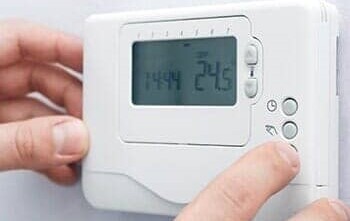
Thermostat Options
Not so long ago, there were only two types of thermostats; manual and programmable. However, technology has evolved quite a bit since those days and has added a third type; the smart thermostat.
While the smart thermostat has a lot of great features, you may want to consider all the options to find out which type is best for your home. Even though newer homes are usually equipped with digital thermostats, it’s still a good idea to know how yours compares to other on the market.
Manual Thermostat
Manual thermostats have to be adjusted whenever you want the temperature to change. They work by using the properties of thermal expansion in a bi-metal strip that closes a circuit when it’s either hot or cold. Older models used a capsule containing mercury that closed the circuit when tipped by the movement of a metal coil that expanded when warm and contracted when cold.
Turning the dial or moving an indicator sets the thermostat to trigger either heating or cooling and will keep a room at about the same temperature over time. Most need to by adjusted based on nighttime or daytime temperatures.
Programmable Thermostat Options
A programmable thermostat works a bit differently than a manual one. You can set a schedule for heating and cooling that allows you to skip the manual adjustment twice or more per day. This works well if you spend a lot of time away from home, and aren’t too concerned about fine tuning the temperature. You can set up a day or week’s schedule and it goes on autopilot, allowing you to tell the HVAC unit to heat or cool to different temperatures depending on the time of day.
Programmable thermostats cost a bit more than manual ones, with the price ranging up to $60.
Smart Thermostats
Smart thermostats are a lot more diverse when it comes to options and features, unlike the manual and programmable ones. In fact, some features are only included on certain models. All smart thermostats have one common feature; they all connect to the internet, which adds significant new possibilities for your home comfort.
With a simplified programming system, you’ll be able to access the smart thermostat’s features and control it without having the need to physically interact with it. Most work via a smartphone app like Nest, which makes it even more accessible than a programmable thermostat. If you’ve ever tried setting a programmable thermostat, you know it can be a bit difficult and inflexible. The interface with a smart model is much easier to manipulate and adjust right from your phone, anywhere there’s an internet or mobile signal.
Many have energy saving features, reminders for maintenance and filter changes, and so on. Your smart thermostat can email you a report showing statistics on heating or cooling function, complete with comparisons of other smart thermostats in your neighborhood.
This is the most expensive type of thermostat, costing around $100 to $200. Another downside is that most of them are powered by a long-life battery instead of the low voltage wire installed for older types of thermostats. And be sure to check if your HVAC unit is compatible with a Nest or other smart thermostat.
Is your house eligible for a smart thermostat? Do you want something a little more old-fashioned? Is your HVAC unit compatible with newer models of thermostats? These are questions you need to ask yourself before making a decision. Ultimately, the decision is what works best for you and your HVAC needs.




